Lead generation is a top priority for B2B marketers.
That’s not surprising. After all, more leads equal more sales.
However, lead generation is easier said than done. Today’s B2B customers are intelligent, and competition is fierce.
In a survey of 680 marketing executives, 59.9% ranked B2B lead generation as a leading marketing goal, on par with brand awareness.

While there is no foolproof way of generating leads for your business, the good news is, you can make it easier. This article will explore 11 proven tips to optimize your B2B lead generation campaigns.
What is B2B lead generation?
Lead generation refers to the process of collecting the contact information of potential buyers. The goal is to use this data to nurture and convert them into paying customers. B2B stands for business to business.
So, the customers you’re targeting are companies and not individuals, as in B2C (business-to-customer) lead generation.
A simple way to think of lead generation is as give and take.
If leads want to download an eBook or test your product, they must share their contact information.
The lead generation form captures this transaction, as shown below.

Typical form fields for B2B leads include name, work email, and industry. Asking for unnecessary information creates friction, decreasing completion and conversion rates.
To get to this point, marketers use various marketing tactics like social media marketing, performance max campaigns, and SEO to attract qualified leads.
These are most likely to convert to customers because they show interest in your product or service.
That said, there are two types of qualified leads.
- A marketing qualified lead (MQL) shows interest in your products or services based on marketing campaigns. They may have subscribed to your newsletter or downloaded an eBook.
- A sales qualified lead (SQL) demonstrates high intent to buy. They have engaged with your sales team by requesting a demo.
Most leads start as marketing qualified leads and, through nurturing, become sales qualified leads.
How is B2B lead generation beneficial?
B2B lead generation is important because it impacts revenue and sales by generating leads who are potential customers. An effective B2B lead generation program ensures that your sales pipeline is active, so you don’t miss opportunities for revenue growth.
A B2B lead generation strategy offers these primary benefits:
Identifies ideal customers
Lead generation provides insight into your target audience. Gathering customer information, such as industry or job roles, tells you who’s interested in your products or services.
For example, you may be targeting companies in the eCommerce space, but lead generation shows you a significant number of leads are in the SaaS industry.
Builds brand awareness and visibility
B2B lead generation strategies like search engine optimization (SEO) and PPC marketing place content in front of your target audience, delivering high-quality leads. Incorporating relevant keywords into your content and ads ensures the people looking for you find you.
Helps with targeted content creation
Lead generation pinpoints where customers are in the buyer journey. That allows you to create a B2B content marketing funnel and tailor messages to their needs. For example, you can skip top-of-funnel and middle-of-funnel marketing if you capture a lead through a bottom-of-funnel lead magnet.
Improves sales pipeline flow and conversion
Lead generation provides your sales funnels with a steady flow of high-quality leads to nurture and convert. It allows your sales team to focus efforts on promising prospects, keeping the sales cost ratio low and conversion high.
3 ways to generate B2B leads
We know what B2B lead generation is and how it supports business growth. But how does it work?
Here are 3 ways to find B2B leads for your business.
Identify your target buyer
It is critical to know who your target audience is before contacting them. Otherwise, you’re wasting time and effort on leads that may or may not convert.
That’s why you need to create buyer personas, like this one:

Buyer personas focus your sales and marketing teams' efforts on the right customer.
These data-driven characterizations of your ideal customer outline their industry, job title, purchasing power, goals, pain points, content, and channel preferences.
The more you know about what makes leads desirable, the more likely you’ll find prospects that fit your profile.
You may need multiple personas because the B2B sales process usually has more than one decision-maker.
Select suitable marketing strategies
With a clear picture of your ideal customer, you can choose appropriate marketing strategies to attract them. These fall into two categories.
- Inbound marketing strategies attract leads through tailored content creation.
- Outbound marketing strategies generate leads through cold outreach.
There’s no one-size-fits-all B2B lead generation strategy. Instead, a mix-and-match approach combining inbound methods like SEO with outbound efforts using cold calling software such as CloudTalk will give you the best chance of attracting quality B2B leads.
Start qualifying and prospecting
Chasing weak leads wastes time and decreases sales productivity.
Therefore, you must define what makes a qualified (good) or unqualified (poor) lead so your sales and marketing teams can focus on the best conversion opportunities.
Factors you might consider are:
- The industry the lead is in (do they need your product/service?)
- Your existing churn data from customer success (have past lookalike customers churned?)
- Income or revenue range (can they afford your product/service?)
- Click-through rates (are they interested in your product/service)
- Stage in the buying process (do they have high purchase intent?)
Lead qualification ranks prospects by their level of interest, purchasing ability, and purchasing time frame.
Once you’ve identified high-value leads, you can reach them through social media, events, SEO, email, or cold calls.
Sales prospecting software accelerates this process, helping you find and filter potential leads by business type, size, income, and other criteria.
11 B2B lead generation tips you can't ignore
It would be great if sales leads fell on your lap, but that’s not the reality for B2B marketers. You must implement best practices for your business to succeed in B2B lead generation.
Below are 11 proven approaches for B2B lead generation success.
1. Invest in content marketing
Hundreds of articles have been written about content marketing, and with good reason. Content plays a significant role in the buyer journey. One B2B content study revealed that these buyers consume an average of 13 pieces of content before making purchases.
Just make sure your content marketing pieces inform, engage, and educate prospective buyers on market solutions to their specific problems. These types of content should offer value.
The goal is to get potential clients to share their email addresses with you (in the case of gated content), or, at the very least, keep them interested in your brand until they officially become a lead.
That said, popular lead generation content includes:
- E-books
- Reports
- Free tools
- Videos (We’ll talk more about these later)
- Social media posts (more on this later)
You can even offer templates, like Hubspot does:
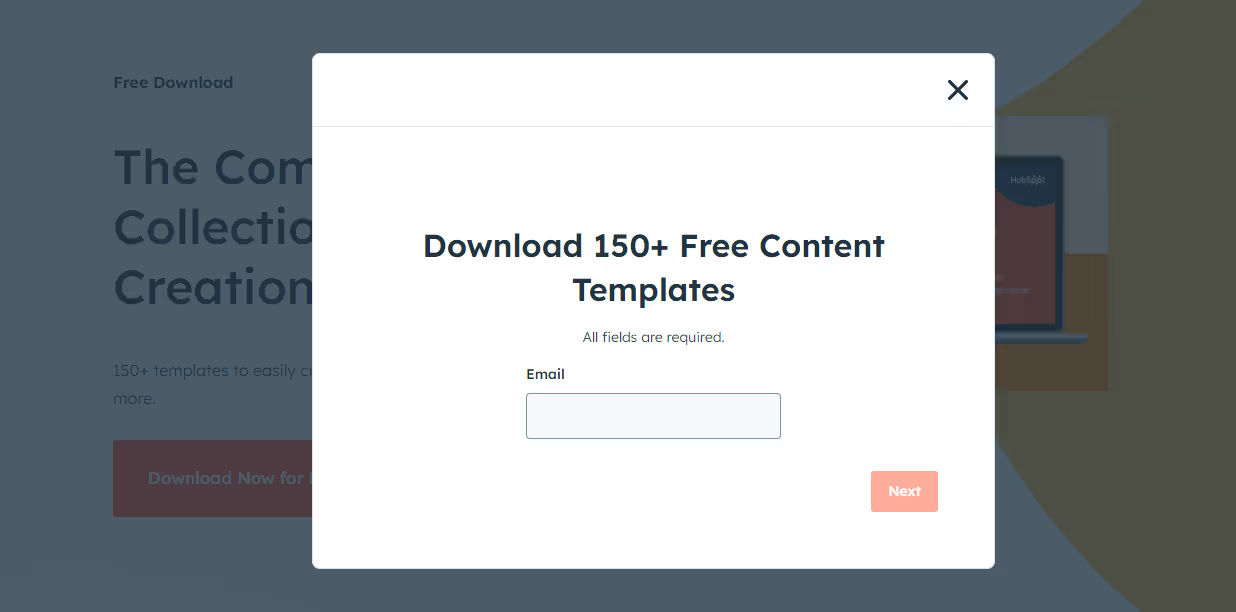
Content marketing is the gift that keeps on giving.
Besides generating B2B leads, it provides search engine visibility, establishes credibility, and is 62% cheaper than traditional marketing.
2. Experiment with video content
Video marketing is one of the most popular types of content marketing, driving 65% of internet traffic.
While brands use videos to improve brand awareness, they can also increase lead volume.
When prospects want to see a standout feature in action, they search for a video. Video content must demonstrate value to generate leads. Think product demos, tutorials, how-to guides, and feature highlights.
You can post your video on platforms like YouTube for B2B lead generation.
But how do you collect customer information using these videos?
- Use YouTube end screens to direct viewers to other videos and the brand’s website.
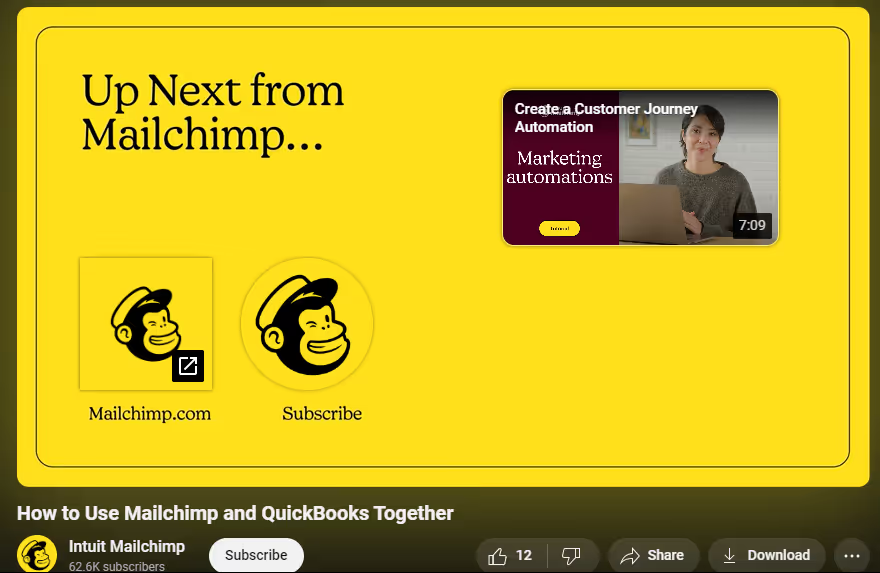
- Add lead generation links to the description area of the video, like the one below.

Another option is to use videos as gated content on your website. You can also leverage landing page videos to increase the perceived value of your lead magnet and boost email opt-ins.
Social media and email videos are great, too. We’ll talk about social selling and email marketing later.
3. Attend industry events
Who says you can only generate B2B leads online?
Offline channels like events are just as effective in B2B lead generation.
A staggering 49% of US B2B marketers use events for this purpose.
Just make sure you attend events where potential clients are. If you’re selling email marketing software, for instance, attending a conference on email marketing topics is probably your best option.
It’s safe to say those who attend such events are interested in email marketing. That means they’ll probably be interested in your product, too.
Make sure you come prepared for your chosen event. Read up on relevant topics that can be interesting conversation points with fellow attendees.
Create an e-business card you can easily distribute.
Enable two-way contact sharing so potential clients can access your lead capture form through the card and give you their email addresses.
With this innovative approach to B2B lead generation, you’ll impress potential clients and easily generate B2B email sign-ups. Plus, you can automatically build your digital address book!
4. Utilize search engine optimization (SEO)
SEO generates leads by optimizing web pages so they rank on search engines for search queries.
The higher you rank in the search results, the more visible you are to buyers looking for your products and services.
SEO achieves this in three ways.
Keyword research
Using the right keywords is vital to online visibility.
Potential leads aren’t likely to find your content or web pages if you don’t incorporate the search words or phrases they use. You can use Surfer to find keywords that match the search terms that users are looking for.
That way, your website will show up when someone types in a Google query related to your product.

Quality content.
Informative content that solves your readers' problems is fundamental to winning trust and authority among your audience and search engines.
Writing articles on your expertise can help demonstrate your expertise and stay top of mind for potential customers interested in your product or service.
Use AI copywriting tools to help you write articles faster.
Link building
High-quality backlinks to your website tell search engines that your content is valuable and deserves more visibility.
They also extend your reach to new audiences.
Technical SEO
Your website’s performance affects search rankings. It examines site architecture, loading speed, internal links, and other factors to enhance website rendering, crawling, and indexing.
Perform regular content audits to identify broken links and underperforming or outdated content. Many SEO tools streamline content auditing by automatically analyzing your website for SEO opportunities.
5. Use LinkedIn social media advertising
People use social media to discover and research businesses and their products.
And if you’re a B2B marketer, LinkedIn is the place to connect with your target customers.
LinkedIn stats show that 80% of social media B2B leads come from the professional networking website.
LinkedIn offers various ad formats.
- Sponsored content ads
- Sponsored messaging ads
- Text ads
- Video ads
- Dynamic ads
Below is an example of a sponsored conversation ad

Lead gen forms, a feature of sponsored content and messaging, enable marketers to collect contact information from potential customers.
When a user clicks an ad’s CTA, it directs them to a lead generation form like the one below.
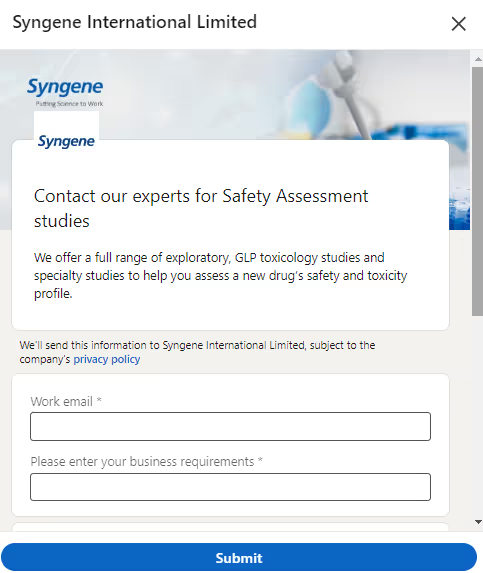
Depending on how complete a user’s profile is, the form automatically populates with information like their name, email, company, and industry.
Another key benefit of using LinkedIn for B2B lead generation is native targeting.
The platform has tools to target audiences based on demographic, geographic, and behavioral data.

LinkedIn segments audiences based on location, industry, company size, roles, job functions, etc. You can also create custom audiences with data from your CRM and email lists.
To get started with LinkedIn advertising, you need to create an account in Campaign Manager.
Then just choose your marketing objective (lead generation), then set your budget, ad format, and targeting criteria.
6. Run Google search pay-per-click (PPC) campaigns
Apart from LinkedIn social media ads, there are other pay-per-click campaigns you can run.
Let’s talk about Google search PPC.
SEO helps lead-generating content rank for organic search results, setting you up for long-term success.
However, it takes a few months, and sometimes you want faster results.
That’s where this type of pay-per-click campaign comes in for faster results.
You only have to pay.
Here’s a summary of how it works: marketers bid on the keywords they want their ads to rank for. When potential customers use those search words, the ad appears at the top of the results page.
Let’s say you’re a computer chip manufacturer.
The keywords you would bid on include EMS electronics, best electronic manufacturers, circuit board manufacturers, etc. Your ad will appear whenever people use those search terms.
See the example below.

The top results for the above search are paid ads. More than 40% of all clicks go to the top three ads.
But pay-per-click advertising in general gets expensive.
After all, you pay every time someone clicks the ad, so you want to ensure that best practices are in place.
A good B2B marketing strategy is to combine search engine optimization best practices and paid advertising.
Ensure your page loads quickly by optimizing images and choosing a performance-optimized hosting solution.
Your landing page should also deliver on the promise of the ad and incorporate your lead capture form.
You’ll need to create a Google Ads account to set up your Google search PPC campaign.
7. Leverage alternative social media platforms
LinkedIn may be the world’s largest B2B database and YouTube another widely used social platform by B2B marketers (53% of B2B marketers leverage the channel!).
But that doesn’t mean they should be the only social platforms you should use for your B2B lead generation.
While primarily seen as B2C social channels, Facebook, Instagram, and X (formerly Twitter) also provide great opportunities for B2B advertising and social selling (more on this later).
Robin, which offers a work experience solution, is a great example of a company that uses a channel many brands use for B2C lead generation to get B2B leads.
See how active the brand is on Instagram:

But don’t just create an account on these alternative platforms just because.
You have to ensure your potential clients use those channels in the first place. Refer to your buyer personas to determine which specific alternative social platforms to leverage for the best results.
8. Adopt social selling
If you’re not advertising on LinkedIn, Facebook, Instagram or those other social channels, you should engage in social selling on these platforms for effective B2B lead generation.
Social selling leverages social media platforms to build relationships with potential customers.
Here, “selling” refers to the sales process, not the actual sale. So, if you’re making aggressive sales pitches instead of engaging with followers, you’re doing it wrong.
Here are the main components of B2B social selling:
- Engagement. Liking, sharing, and replying to comments makes your brand approachable and shows audiences you care about their interests and opinions. You also showcase brand personality, creating deep emotional bonds with customers.
- Content creation. Posting organic relevant and informative content encourages engagement, establishes trust, and positions you as an industry authority. The more valuable insights you share as part of your social media content marketing, the more likely prospective customers will become willing leads.
You can leverage social listening tools to track brand mentions and stay on top of comments and direct messages to respond to them.
As for social media content creation, just make sure you leverage a wide variety of content formats (check out our Robin example above).
If you churn out similar content all over again, you might end up turning away potential clients instead.
You can use a social media calendar to plan your social content and ensure variety.
Consider asking employees to do the social selling for the company, too. Social selling is more effective from employee (specifically C-suite) accounts than business accounts because people trust individuals more than brands.
Plus, they prefer employee-generated content to brand-generated content, with the former getting eight times more engagement than the latter.
9. Implement email marketing campaigns
Email marketing is a great strategy for generating sales qualified leads.
Despite being one of the oldest forms of digital marketing, email outperforms other marketing channels with an ROI of $36 for every dollar spent.
Sending regular emails to subscribers builds long-term relationships and keeps you at the top of their minds.
The type of emails you could send include:
- Feature announcements
- New content, such as blog posts or webinars
- Surveys
- Newsletters
- Events
Below is an example of email lead generation for a webinar event.

Implementing effective email marketing campaigns isn’t complicated, with the following best practices in place.
- Build a list of quality leads. Having thousands of subscribers isn’t the flex you think it is if most don’t engage with your content. You’re better off with a couple hundred engaged subscribers. You also save money on email software that charges per contact.
- Craft compelling subject lines. These get potential customers to open your email. 69% of recipients mark email as spam based on the subject line alone. To ensure this doesn’t happen to you, use customer’s names or most recent transactions in your subject lines.
- Keep email concise. People don’t have time to read lengthy emails. The goal of the email body should be to get subscribers to click the CTA button. Use visuals (images, videos, and interactives) to engage subscribers and deliver the message succinctly.
- Implement main content personalization. We’ll talk more about this in the next section.
Email marketing software helps you get the most out of your campaigns. They streamline email creation and distribution and track performance along vital metrics like open and click-through rates.
10. Personalize your content
Personalizing content–whether it’s your email content, a blog post, or an ad–is about creating content that matches customers’ needs and behaviors.
When you personalize content, you increase the chances of conversions.
An essential part of personalization is understanding the customer’s buyer journey. There are four major stages of the marketing funnel:
- Awareness – where the prospect becomes aware of their problem.
- Consideration – where the lead researches market solutions to their problem.
- Decision – where the customer purchases your solution to their problem.
- Delight – where the satisfied customer refers the software to their peers.
Knowing where consumers are in their buyer journey empowers you to create relevant content that will prompt them to take your desired action.
Don’t share an eBook on how users can maximize use of your product as a lead magnet right after your blog post on basic email marketing concepts.
You won’t get email sign-ups that way.
After all, those who read your blog post are still probably in the early stages of getting to know their problem.
Now if your aim is to generate sales qualified leads via email, then it’s probably a good idea to incorporate social proof into your content.
These are people who are already interested in your product (that’s why they subscribed to your mailing list). Those glowing customer reviews can be the final nudge they need to ask for a product demo.
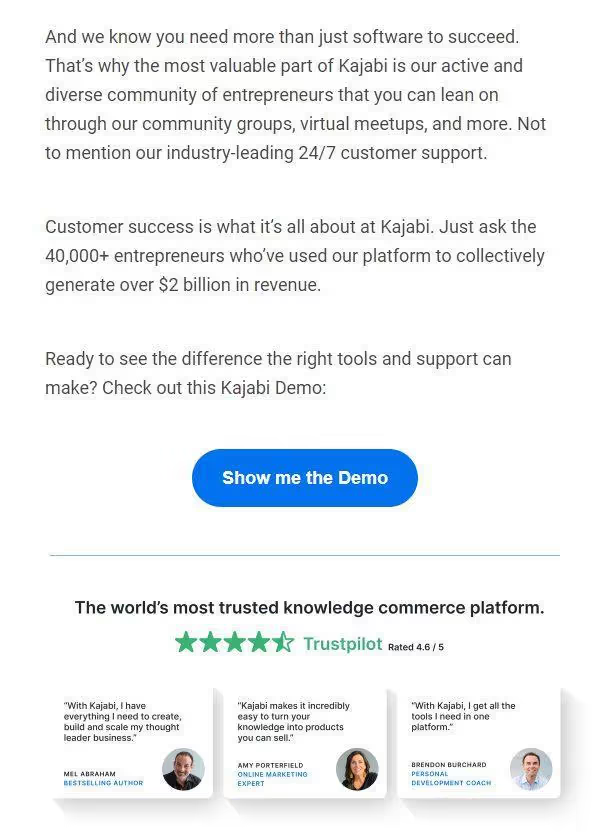
Besides tailored content, you can also personalize content delivery.
Marketing automation allows you to schedule social media posts and emails to arrive when your potential clients are most likely to see them. That is perfect when your audience is across different time zones.
11. Conduct A/B tests
There’s no such thing as a perfect lead generation campaign.
At least not on the first try. However, you can get close through testing.
A/B or split testing compares two versions of your content to identify the elements driving conversion.
Ideally, the two pieces of content should be virtually identical except for a component.
Check out the example below.
There’s a single difference between the two lead capture forms: the quantity of fields.
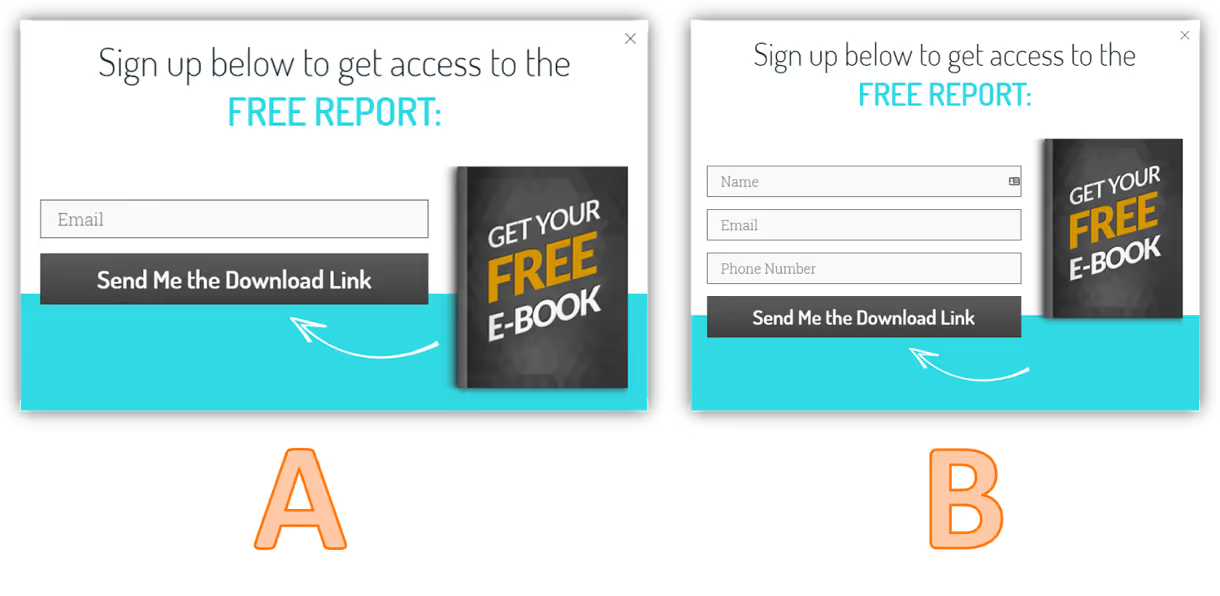
You can experiment with different colors, layouts, fonts, images, and wording to find what resonates with audiences.
However, don’t test too many elements at the same time. Otherwise, you’ll have a hard time discovering which specific element led to the improved metrics.
Conclusion
B2B lead generation is the foundation of sales growth. An increase in leads translates to an increase in revenue. Implement B2B lead generation practices and you can expect a steady flow of sales leads.
From content marketing to attending industry events and personalizing content, these tips will help you easily attract untapped customers.
With a boost in your B2B lead generation efforts, you can expect to boost sales and ensure business growth as well. Best of luck!






